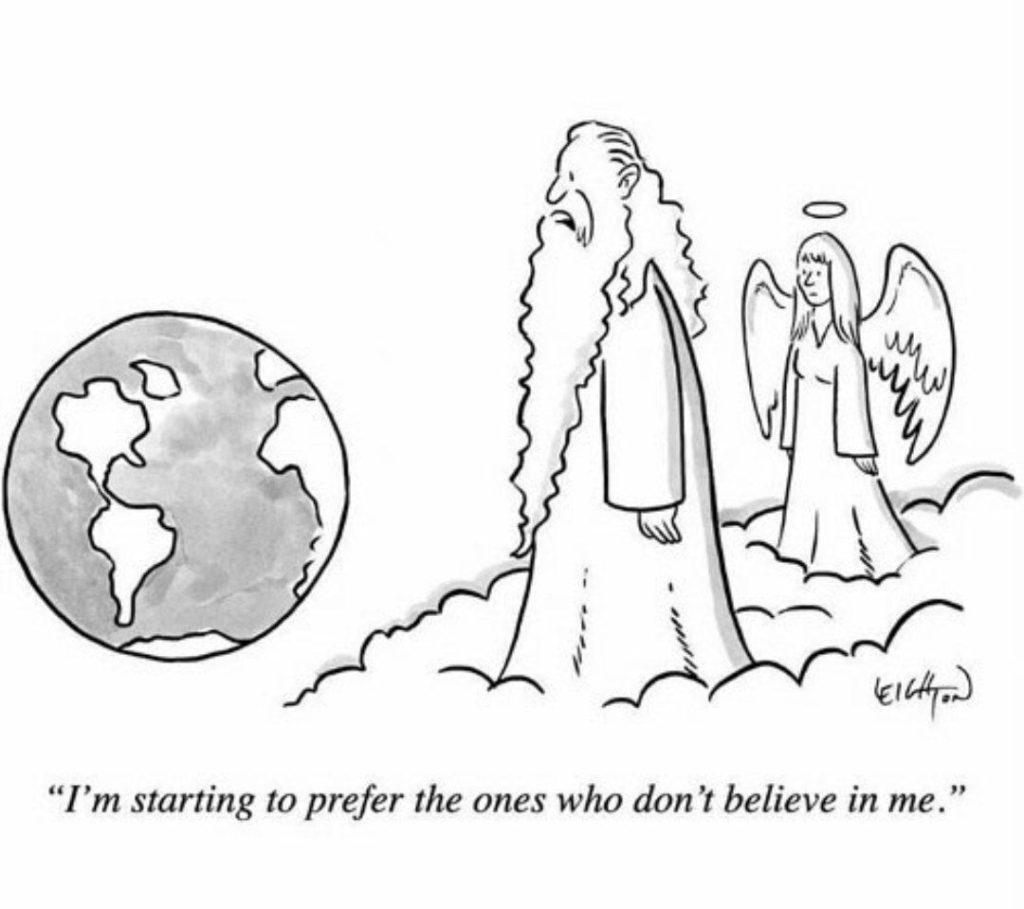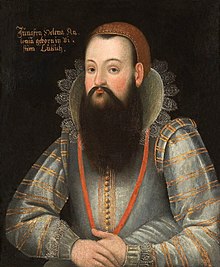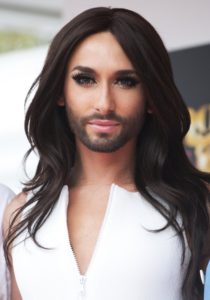How Long is God's Beard?
A reflection on the historical connection between beards and religious masculinity

New Yorker cartoon featuring God with a long beard
“Ye shall not round the corners of your heads, neither shall thou mar the corners of thy beard.”
–Leviticus 19:27
“[Those] who have stamped their character on history – Egyptians, Indians, Jews, Assyrians, Babylonians, Persians, Arabs, Greeks, Romans, Celts, Turks, Scandinavians, Slavs – were furnished with an abundant growth of this natural covering….their hardiest efforts were contemporaneous with the existence of their beards.”
–Thomas S. Gowing, The Philosophy of Beards (1854)
***
For more than a century an imposing granite bas-relief sculpture has stood on the grounds of the University of Geneva, over thirty feet tall and stretching three hundred feet along a leafy quad, depicting stern golem-like representations of ten figures central to the most austere manifestation of the Protestant Reformation. The International Monument to the Reformation was designed by a Swiss architectural firm to commemorate John Calvin’s quadricentenary in 1909, and ironically carved by the French sculptor Paul Landowski, most famous for Rio De Janeiro’s monumental and very Catholic Christ the Redeemer. The central panel of Landowski’s Reformation presents Calvin, his deputies William Farel and Theodor Beza, as well as John Knox, the Scottish founder of the Presbyterian Church. While all four men are slightly variable in appearance – the cut of a robe here, the stature of a figure there – they’re largely interchangeable. With their robes, skullcaps, and clutched Bibles looking nothing so much like occult grimoires, these Reformation theologians remind one of wizards. This is in large part due to their long, hefty, sculpted, tapered, and elaborate beards. Monumental beards warrant monumental sculptures, it would seem.
Following Henry VIII’s death in 1547, the Archbishop of Canterbury Thomas Cranmer grew a long beard, the formerly clean-shaven priest supposedly donning whiskers in mourning for his king, but to critics it appeared to be a clear a sign of sympathy with those more radical reformers on the continent. For Cranmer, being a Protestant meant being bearded. If Cranmer was looking for inspirations among the ministers of Europe, there was no shortage. In addition to Calvin, Farel, Beza, and Knox with their tangled face-jeremiads rebuking the clean-shaven priests of the Roman Catholic Church, there were, to grab an assortment of prominent names, Philip Melanchthon, Martin Bucer, or Heinrich Bullinger (variously bearded and non-bearded throughout their lives). Diarmaid MacCulloch explains in The Reformation: A History that as the schism progressed, reformers donned beards to make “a theological point that clergy were not a caste separate from the laity,” and that conveniently a “full beard would make them look like everyone’s picture of an Old Testament prophet.” There were, of course, exceptions to this rule – many of the earliest Lutherans remained clean-shaven, including Martin Luther (though in Lucas Cranach the Elder’s 1532 portrait he has a scattering of fashionable stubble). And while the beard became a sartorial choice of reformers, the fashion caught on among leaders of the Catholic Church as well with, among other pontiffs, Pope Clement VII, sporting a beard every bit worthy of a Puritan divine.
In a portrait of Cranmer housed at Lambeth Palace and made by an anonymous artist around 1560, the reformer is resplendent in his full hirsutism. Bedecked in his priestly white stole and black vestments, the wizened Cranmer looks out wearily over his long, cleft, white beard. The heft of his whiskers seemingly equivalent to the weight that sits upon his ecclesiastical shoulders – a serious man with a serious beard. Now, compare that to a portrait of a contemporary of Cranmer’s, held at the National Museum in Wroclaw, Poland and also made by an anonymous artist, this one a few decades after the painting held at Lambeth. Both share certain conventions of northern Renaissance portraiture; the proportions of the figures and how they occupy their frames are the same, their centered gazes are the same, the scripts in the corner announcing their subjects’ identities are the same, the inchoate background darkness out of which they emerge is the same. Even the beards are of an equivalent impressiveness, the subject of the Wroclaw portrait sporting one the same length as Cranmer’s. The Wroclaw portrait isn’t of a Protestant reformer, however, but rather of Helena Antonia, a bearded woman who was the court dwarf of Maria of Austria, the Holy Roman Empress.

Helena Antonia
If Cranmer’s beard was intended to signify his stateliness, then Antonia’s portrait was painted for a different purpose. Where Cranmer’s beard is configured as natural and virile, Antonia’s is aberrant and other; where Cranmer’s facial hair signifies his masculinity, Antonia’s is supposed to demonstrate a disorder in conventional gender. When a viewer looks at Cranmer, he gazes out, but the spectator is compelled to gaze at Antonia. Though a member of the Imperial court, Antonia was of a familiar cultural type, the person whose features are coded as abnormal and who is held up for the condescension and derision of their audience. Writing about the nineteenth-century carnival shows, which adapted European aristocracy’s court jesters and dwarves for public consumption, literary scholar Rosemarie Garland-Thomson claims in Freakery: Cultural Spectacles of the Extraordinary Body that the “freak is an object of simultaneous horror and fascination because… the freak is an ambiguous being whose existence imperils categories and oppositions dominant in social life.” Facial hair is a simple anatomical reality for many – of all genders, ethnicities, nationalities, and religious backgrounds. A beard, however, becomes a cultural construct, and the “bearded lady” regularly signifies transgression. The literal reality of Cranmer and Antonia’s beards are identical, but it’s that equivalence which makes the later deviant in the eyes of the viewer. Who is allowed to have a beard is never a neutral question, and across cultures and traditions the answer is normally “Not women.” Such a binary opposition relies on the understanding that beards are to suggest masculinity, and the lack of one, femininity, so that a bearded woman undermines the duality. Thus Antonia becomes an object of derision, mockery, and spectacle, while Cranmer remains a figure of respect.
Antonia is, admittedly, an extreme example, and yet the principle remains the same more broadly – in most of Western culture beards are for men, even if a woman is capable of growing one. And so a depilatory industry has developed to force a cultural conformity upon humans, one which bodies in their magnificent diversity don’t naturally recognize. For the Protestant reformers, according to MacCulloch, beards “provide an example in patriarchal masculinity,” grown so as to emphasize, “that their male sexuality was no different from that of laymen.” The exhibition of Antonia has a very different purpose. Beards are thus claimed not just by the patriarchs, but also by the patriarchy. Such cultural regulation is intimately tied to religion; how could it not be? Just as language, dress, and diet, even in ostensibly secular contexts, can be tied back to sacred categories, so too is the issue of facial hair, from who is allowed to wear a beard, to what that beard should look like. Beards are associated with, among other traditions, Judaism, Islam, Eastern Orthodoxy, Sikhism, Rastafarianism, and early Mormonism (though prohibited today), and rules governing beards can be wide-ranging. As the most prominent of phenotypical secondary sexual characteristics associated with maleness, the beard can’t help but imply certain connotations. But as Antonia and Cranmer’s examples show us, it’s never that simple.
 For all that beards are used to signify membership among a particular faith, and for all that people often imagine even God as being bearded, it’s just as true that being ritually shorn of facial hair often has its own associations with the sacred. There are bearded Hasidic rabbis and clean-shaven Buddhist monks; Amish farmers with their chinstrap beards and Jainist initiates plucking their faces bare. Facial hair, and its lack, can both be forms of drag, true to philosopher Judith Butler’s contention in Gender Trouble that “identity is performatively constituted by the very ‘expressions’ that are said to be its results.” A beard can mean many things, and sometimes God uses a Gillette. Not even Jesus is always bearded, as is the case with some early Byzantine depictions of him as smooth and androgynous as Apollo. Whether a denomination embraces the beard or not, the presence and reality of male facial hair is a zone of contention over how masculinity is perceived and who gets to lay claim to its title. When it comes to traditional conceptions of what people understand as men’s bodies, only the penis has been endowed with more significance as a site for potential anatomical holy war, but it’s (usually) less visible than a beard.
For all that beards are used to signify membership among a particular faith, and for all that people often imagine even God as being bearded, it’s just as true that being ritually shorn of facial hair often has its own associations with the sacred. There are bearded Hasidic rabbis and clean-shaven Buddhist monks; Amish farmers with their chinstrap beards and Jainist initiates plucking their faces bare. Facial hair, and its lack, can both be forms of drag, true to philosopher Judith Butler’s contention in Gender Trouble that “identity is performatively constituted by the very ‘expressions’ that are said to be its results.” A beard can mean many things, and sometimes God uses a Gillette. Not even Jesus is always bearded, as is the case with some early Byzantine depictions of him as smooth and androgynous as Apollo. Whether a denomination embraces the beard or not, the presence and reality of male facial hair is a zone of contention over how masculinity is perceived and who gets to lay claim to its title. When it comes to traditional conceptions of what people understand as men’s bodies, only the penis has been endowed with more significance as a site for potential anatomical holy war, but it’s (usually) less visible than a beard.
 Historian Christopher Oldstone-Moore explains in Of Beards and Men: The Revealing History of Facial Hair that as religions “formulate specific values and norms, they deploy hair… to proclaim these ideals to the world. When disputes arise about contrasting models of masculinity, different treatments of facial hair may indicate where one’s loyalties lie.” As during the Reformation, where Cranmer’s prodigious late-life beard signaled his loyalty to the hotter variety of Protestant, or when a Haredi Jew’s beard is a rejection of Jewish assimilation to Christian cultures. The point isn’t that beards represent some particular thing, rather that they simply represent something — wisdom and wildness, ecstasy and staidness, virility and age — it depends on individual context. Whiskers also signify something about the sacred – be they an Orthodox priest’s mighty follicles or a Rasta’s dread-locked beard – though, again, that something is variable. Even for secular modern faiths, from political ideologies to consumerist enthusiasms (which are often just as religious), beards are still laden with significance (and often in similar ways).
Historian Christopher Oldstone-Moore explains in Of Beards and Men: The Revealing History of Facial Hair that as religions “formulate specific values and norms, they deploy hair… to proclaim these ideals to the world. When disputes arise about contrasting models of masculinity, different treatments of facial hair may indicate where one’s loyalties lie.” As during the Reformation, where Cranmer’s prodigious late-life beard signaled his loyalty to the hotter variety of Protestant, or when a Haredi Jew’s beard is a rejection of Jewish assimilation to Christian cultures. The point isn’t that beards represent some particular thing, rather that they simply represent something — wisdom and wildness, ecstasy and staidness, virility and age — it depends on individual context. Whiskers also signify something about the sacred – be they an Orthodox priest’s mighty follicles or a Rasta’s dread-locked beard – though, again, that something is variable. Even for secular modern faiths, from political ideologies to consumerist enthusiasms (which are often just as religious), beards are still laden with significance (and often in similar ways).
In domains as wide-ranging as philosophy, politics, and popular culture, the beard remains a site of disagreement. An enterprising intellectual historian could do worse than to trace the ways philosophical systems are reflected in an era’s facial hair, positing some kind of relationship between base and stubble-structure, if you will. Look at the eighteenth-century: the Enlightenment consciously rejecting all of those wizard-like Reformation beards, as if superstitious Christianity could be scraped away with a straight edge. The philosophes of Enlightenment salons preferred the clean look of classical Rome, a parsimonious face reflecting a rational philosophy. In contrast to the Renaissance and the Reformation, not a single major Enlightenment thinker had a beard. Not John Locke or Benedict Spinoza, Wilhelm Gottfried Leibnitz or David Hume, George Berkeley or Immanuel Kant. Not Voltaire or Rousseau. Rene Descartes did have a goatee, but it made him appear more like Frank Zappa than the prophet Elijah.
Separate from philosophy, we ought also to examine the beard in politics. The U.S. presidents serve as an example to the waxing and waning of beard popularity, and as an illustration of semiotics of male facial hair, which even in the ostensibly secular Oval Office finds its origin in the theological, no matter how obscured. The first American presidents, inheritors of Enlightenment salons (and barbershops), embraced the same fresh, clean look. The first follicle-enhanced president was John Quincy Adams, who along with his mutton chops was elected in 1825, well into the beard-friendly Romantic era. Another great beard would await the election of Abraham Lincoln (Martin van Buren notwithstanding), with a renaissance of bearded presidents following traitorous Andrew Johnson’s clean-shaven interregnum. From U.S. Grant until Teddy Roosevelt, every American president had some sort of facial hair with the exception of William McKinley (and they shot him). Some of those presidents had relatively staid facial hair, like James Garfield’s sober handlebar, or Grant’s clipped beard that made him look like a liberal economics professor, while others, like Rutherford B. Hayes and James Garfield’s had downright rabbinical beards. After Teddy Roosevelt, no other president would sport one (though, in failure, Al Gore grew a righteous depression beard).
Cultural historians have probed why the nineteenth-century saw a proliferation of mighty beards, all of those Civil War officers that looked less like they were West Point graduates than Old Testament characters, and the answer is multifaceted. The enduring influence of Romantic Sturm und Drang with its valorization of “the natural man” was manifested in America by the revivals of the Second Great Awakening, when beards from Brigham Young to John Brown took on an epic caste. For those of a radical political perspective, the bohemian beards of the European revolutionaries of 1848, like Italian partisan Giuseppe Garibaldi’s, provided another impetus. From such radical strands would be woven conventional style, for as Oldstone-Moore notes “When respectable men no longer feared hairy radicals, they no longer feared hair and were free to avail themselves of its possibilities… Beards lost their political meaning and became instead tools to restore notions of patriarchy and manly dignity,” so that President Hayes and Walt Whitman could sport the same style, even while the former rejected the splendor of the barbaric yawp.
Such a cultural politics of the beard endures. For much of the twentieth-century to be clean-shaven was to be the square, conservative upholder of the status quo. By contrast the beard was the provenance of the hippie, beatnik, and freak, a countercultural declaration rejecting American uniformity. More recently, conservatives have heartily reclaimed the beard for themselves, taking it from Allen Ginsberg and giving it over to former Speaker of the House Paul Ryan and Senator Ted Cruz (the latter of whom actually looked good, as distressingly reported by both Esquire and Slate). The beard isn’t the provenance of the Yippie anymore, but now that of the militia member; it’s sported not by beat poets, but by MAGA zealots with Gadsden flags and Punisher skull patches. A dark irony in this though, as much of the exclusionary Islamophobic rhetoric that intensified after 9/11 centered on the facial hair of Muslim men, with harassment and hate crimes often focusing on men who appeared to be Muslim because of their beards (as well as attacks on bearded men who belonged to other religious traditions, such as Sikhism). The bearded fascists who mock and attack Muslim men for also having beards aren’t hypocrites; they’re authoritarians reveling in the sadism of arbitrary power. Their point has never been that men shouldn’t have beards, but that they’ve decided certain people shouldn’t have them – namely those whose religious difference requires them precisely to grow a beard. The xenophobic racists declare, “Beards for me and not for you.” As Adam Bonenberger and Adam Weinstein argued in The New Republic, “the wholesale injection of facial hair into the American mainstream by veterans, law enforcement, and conservatives also fuels a familiar joyful cultural urge toward dominion and power.”
 Strung between hipsters and the Tea Party, one wonders if God even wants His beard anymore. God is of course the big lacunae in any discussion about beards and faith, since the deity is so often imagined as bearded, from the Sistine Chapel to William Blake, cartoons in The New Yorker to The Simpsons. Such a question is facetious – God never had a beard, or He simultaneously has and doesn’t have one. Theology is beyond the realm of mere semiotics. When the kabbalists posed questions about the length of God’s beard, they never intended their questions to be taken literally, nor should depictions of a hirsute creator made by Michelangelo be seen as intending to reflect a reality. Beards endlessly defer their meanings, though God (or “God”) is a signifier forever looking for a signified. Facial hair would appear to be a bit more straightforward than the Godhead, a follicular symbol of shifting significance, yet forever associated with definitions of masculinity, however it’s constituted.
Strung between hipsters and the Tea Party, one wonders if God even wants His beard anymore. God is of course the big lacunae in any discussion about beards and faith, since the deity is so often imagined as bearded, from the Sistine Chapel to William Blake, cartoons in The New Yorker to The Simpsons. Such a question is facetious – God never had a beard, or He simultaneously has and doesn’t have one. Theology is beyond the realm of mere semiotics. When the kabbalists posed questions about the length of God’s beard, they never intended their questions to be taken literally, nor should depictions of a hirsute creator made by Michelangelo be seen as intending to reflect a reality. Beards endlessly defer their meanings, though God (or “God”) is a signifier forever looking for a signified. Facial hair would appear to be a bit more straightforward than the Godhead, a follicular symbol of shifting significance, yet forever associated with definitions of masculinity, however it’s constituted.

Conchita Wurst
Yet if a beard is to truly gesture towards the transcendent, it is necessary to destroy that arbitrary binary which posits beards as a marker of manhood. God’s face must erase all distinctions and oppositions, so that God appears more like the Austrian drag queen Conchita Wurst. A representative at the 2014 Eurovision Song Contest, Wurst’s appearance is a direct rejoinder to the traditional masculine associations of the beard. With her slender frame and delicate features Wurst would read to many viewers as feminine, and yet she combines her appearance with a closely cropped, dark, thick beard. Such is the ultimate revenge of the bearded woman, the longtime spectacle of freak shows and carnivals, the mockery of gender rebellion triumphantly restated in the unabashed transcendence of Wurst’s beauty. Perhaps in our continuing millennium, Antonia will be seen as equally sacred as Cranmer. Because Wurst appears nothing so much like a depiction of the Sacred Heart of Jesus, the very face of God.
Ed Simon is a staff writer for The Millions, and appears regularly at several different sites. His most recent book is Printed in Utopia: The Renaissance’s Radicalism.
***
Published with support from the Henry R. Luce Initiative on Religion in International Affairs.